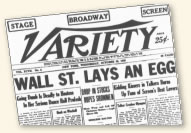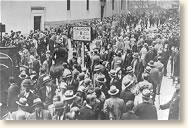
In the late 1920s, it seemed as if everybody was in the stock market. Estimates vary from 1,000,000 to 25,000,000. Why not? Stock prices just kept going up and up, making your original investment more and more valuable. And here was the
 |
Headline from Variety
Oct. 30, 1929 |
best part -- you didn't need a lot of money to get into the market. You could buy on margin. First you borrow the money to buy the stock (interest rates were a phenomenally low 3 1/2%). Then you put up the stock as collateral for your loan. Simple, easy money -- if stock prices go up, you collect your dividends. If the price dips, you raise a little cash to cover your loss and wait for the market to rise again. In 1929, so many people were buying on margin that they had run up a debt of six billion dollars.
The prosperity couldn't last forever. On September 3, the market dropped sharply only to rise and then drop again. It was like tremors before a big earthquake but nobody heeded the warning. The market had sagged temporarily before, but it always came back stronger. The market dipped sharply again on October 4. Some began to sweat as the market continued to decline, then they panicked. October 21 saw an avalanche of selling as many tried to salvage something from their loss. On October 24 -- Black Thursday -- the panic took on a life of its own as selling orders overwhelmed the Exchange's ability to keep up with the transactions.
 |
The curious and bewildered
throng Wall St. as
the news spreads |
Some Wall Street financiers tried to inspire confidence by buying as many shares as they could. It worked -- temporarily. Friday and Saturday saw sales drop and a glimmer of hope return. On Monday the panic started again, and then came Black Tuesday -- October 29. The panic on the Exchange floor changed to bedlam. According to one observer, "They hollered and screamed, they clawed at one another's collars. It was like a bunch of crazy men. Every once in a while, when Radio or Steel or Auburn would take another tumble, you'd see some poor devil collapse and fall to the floor." This was the Crash, although few could see it at the time. The Market continued its decline but never as dramatic. Thirty billion dollars had been lost -- more than twice the national debt. The nation reeled, and slipped into the depths of the Great Depression.

 In the late 1920s, it seemed as if everybody was in the stock market. Estimates vary from 1,000,000 to 25,000,000. Why not? Stock prices just kept going up and up, making your original investment more and more valuable. And here was the
In the late 1920s, it seemed as if everybody was in the stock market. Estimates vary from 1,000,000 to 25,000,000. Why not? Stock prices just kept going up and up, making your original investment more and more valuable. And here was the 

